Patricia Harty was honored at the St. Patrick’s Day festivities in Holyoke, Massachusetts, and decided that if there is a place called Irish America, this could be it.
Its heart, Holyoke, Massachusetts, is still Ireland Parish, which is what it was known as back in the 1800s when immigrants, mainly from the Irish-speaking area of Dingle, Co. Kerry, settled there and found employment working on the dam and canal system, in the paper manufacturing plants and textile mills.
It was a tough existence but they survived, and today in this area of Massachusetts on the banks of the Connecticut River, their descendants are more likely to be judges, politicians, teachers, and doctors than blue-collar workers. But the struggle of those early immigrants is not forgotten, and the pride that Holyokers hold in their Irish roots is evident, especially on St. Patrick’s Day.
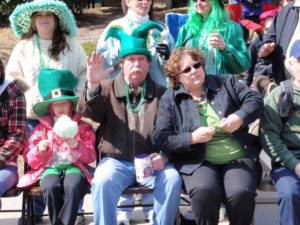
Depending on the weather, and who is doing the talking, the parade status varies between being number one or two worldwide. According to some, the city of 40,000 people draws upwards of 350,000 spectators from Boston, the neighboring townlands of Springfield and Chicopee, and as far away as Chicago.
This year’s parade took place on Sunday, March 22. The weather was crisp and sunny and a sense of fun prevailed. Families held parties on sloping front yards and cheers rang out from porches and sidewalks to the marchers along the 2.6-mile route. The feeling is a little more Mardi Gras than Hibernian with some 40 marching bands and as many floats taking part. This year, for instance, the Grand Colleen float featured giant ice cream cones and a chocolate box, and the Hawthorne Caballeros led off the parade with pulsing music and Latin-inspired costumes – a nod, perhaps, to the large Puerto Rican population that now call Holyoke home.
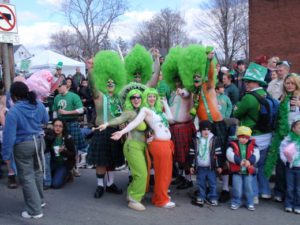
The parade is nothing if not inclusive. The Philadelphia Mummers with their brilliant costumes and accordion and banjo music liven up the crowd, while the Second Marine Aircraft Wing Band strike a reflective note as they call to mind the tradition of Irish-Americans in the Armed Forces, and today’s young men and women who are serving in Iraq and Afghanistan.
Canadians, Poles, and Puerto Ricans all immigrated to Holyoke in large numbers, but none so large as the original Irish settlers who are still prominent in the running of the city and the parade. The celebrations run over several days and keep the 250-strong Parade Committee busy all year planning events such as the Colleen Pageant, 10k Road Race, Bishop’s Mass, J.F.K. Award Dinner (John F. Kennedy and his wife Jackie were guests of honor at the 1958 inaugural dinner), and the Mayor’s Breakfast, at which yours truly was presented with this year’s Ambassador Award.
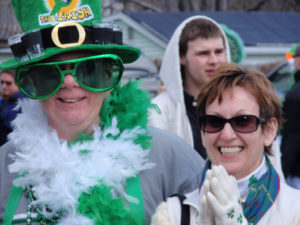
I first heard of Holyoke from the late, great Eoin McKiernan, who penned The Last Word column for Irish America for many years. Eoin was the first Ambassador Award recipient in 1992 and became an ardent fan of Holyoke, promoting the parade whenever he could. But it was at the urging of Ciaran O’Reilly and Charlotte Moore, founders of New York’s Irish Repertory Theatre who served as last year’s Ambassadors, that I finally made the trip. I’m glad I did.
I arrived in Holyoke, three and a half hours north of New York City, at noon-time on Saturday, just as the 10k road race was ending. I had barely put a foot down when I was met by a welcoming party of Fred Sullivan and Jack O’Neill, who soon had me off and running to a whirlwind of engagements.
As we went along, Fred, a labor lawyer with offices in New York and Holyoke, and Jack, a pharmacist of long-standing, filled me in on the city’s colorful history.
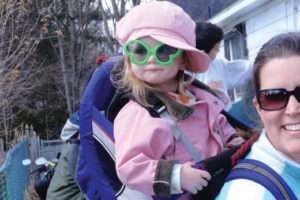
IRELAND PARISH
Holyoke was known as Ireland Parish back in the 1800s, when it was a way station on the road between Springfield and Northampton – a place for weary travelers to refresh themselves at one of the taverns in the area. The first post office, called “Ireland,” was established on June 3, 1822. Another post office called Ireland Depot was opened on February 26, 1847.
By that time, Boston entrepreneurs had seen the potential of the broad plain and the 57-foot drop in the Connecticut River at South Hadley Falls, and devised a plan to dam the river and turn the area into America’s first planned industrial city.
Irish workers began construction on the dam, which was completed on November 16, 1848. (There’s an old saying, “To build a canal all you need is a pick, a shovel, a wheelbarrow, and an Irishman.”) The wooden structure proved no match for the mighty river and less than a day after it opened the dam was swept away to the famous words, “Dam gone to hell by way of Willimansett.” Undeterred, construction began on a second dam. Engineers put an apron in place for the support this time, and the dam held.
One of the laborers on the dam was Irish immigrant Daniel O’Connell who died soon afterward in a cholera epidemic. His son, also Daniel, a water boy on the same river project, became the family’s sole support. Daniel went on to create Daniel O’Connell & Sons Contractors which is still in operation today.
“Of course, lives were lost,” Bob Loughrey, uncle of Joe Loughrey, J.F.K. Award recipient, said of the building of the dam and the four and a half miles of canals that followed.
Bob’s grandmother, Margaret Friel from Buncrana, Donegal, was fourteen when she arrived in Holyoke in 1878. She found work in the mills, which sprang up once the dam was in place, and later as a domestic in the house of William Skinner whose Skinner Silk Mills had thousands of workers. A woman of great fortitude and family loyalty, Margaret saved her money, returned to Ireland, collected her parents, her four brothers, and sisters, a new husband, Constantine Loughrey, and brought them all back to Holyoke.
Window to the Past: Building the Holyoke Dam, 1847
“Patrick Garvey, son of Daniel and Ellen (Moran) Garvey, was born in County Kerry, Ireland, and there resided until the year 1847, when he emigrated to the United States and located in Holyoke, Massachusetts where he spent the remainder of his days. He assisted in building the first dam and during that period acquired the title ‘Bully’ not for any pugnacious tendencies displayed by him. He was a man of large build and great strength, and upon seeing two men fail in placing a large stone in its proper place he went to the rescue and unaided placed it on the scaffolding. The man in charge of the work said, ‘Bully for you’ and Mr. Garvey was ever afterward known by that appellation. He was a man of genial disposition, always ready to assist a neighbor and friend, and was honored and respected accordingly. His wife, Elizabeth (Donnelly) Garvey, bore him seven children: Mary, Ellen, John, Daniel, Patrick H., Thomas J., Michael.”
– The Encyclopedia of Biography
LIVING CONDITIONS
The new opportunities in Holyoke soon began to attract other immigrant groups, particularly French Canadians and Polish workers. The mill owners provided housing close to their factories “so that there would be no excuse for them being late for their twelve-hour shifts,” Bob says.
The tenements and row houses provided were often small and crowded. According to one 1875 report by the state’s Bureau of Statistics of Labor: “Holyoke has more and worse large tenement houses than any manufacturing town of textile fabrics in the state. One large block, four stories high, has 18 tenements with 90 rooms, occupied by nearly two hundred people; and yet there are only two, three-feet doorways on the front, and none on the back. Our agents visited some tenements having bedrooms into which neither air nor light could penetrate, as there were no windows and no means of ventilation.”
Not only were the living conditions harsh, but the wages were poor – many families were in such dire straits that young children were forced into the workforce. The census of 1880 shows “only” 700 minors between the ages of 10 and 16 years employed in the mills. The following year that figure rose to 1,501.
DILLON’S BLOCK
In 1875, work began on a new building, a huge complex at Maple and Hampden streets, and when it was completed many of the Irish moved there. Built by two brothers from Ballyduff, Co. Kerry, “Dillon’s Block” was often referred to as “Dillon’s Baby Factory” because so many of Holyoke’s new citizens were born there.
One of those citizens was Joseph Loughrey, the eldest of Margaret and Constantine’s twelve children. “My father and two of his sisters were born in Dillon’s Block, and then the family moved to a house. He was one of twelve, one died in infancy and two died with flu when they were three and four,” Bob says.
He tells me that his father, Joseph, had wanted to go to college but the family situation didn’t allow for it. “He was very good at mathematics and he wanted to complete his schooling but his mother asked him to get a job so that he could help out. He agreed, but made her promise that with his help his four sisters would get an education and she kept that promise.”
Joseph became a successful businessman and made sure that his own children went to college. Bob became a schoolteacher, another brother became a college professor, and another had a successful career as a salesman. His sisters also had careers.
The belief in education and also some of the grit and determination of Margaret Friel carried down to her great-grandson, also called Joe, who received this year’s J.F.K. Award. The oldest of eight children, Joe (one of Irish America’s Business 100) recently retired as Vice Chairman of Cummins, the world’s largest independent diesel engine manufacturer, after a 35-year career.
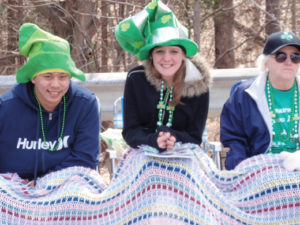
CHURCH & SCHOOL
It was hard not to think of Margaret Friel and that generation of immigrants as we assembled in St. Jerome’s Church for the Bishop’s Mass on the eve of the parade. St. Jerome’s was the rock on which the future of those young Irish pioneers was built.
Bishop Timothy A. McDonnell, a Bronx man, con-celebrated Mass with Father Francis Sullivan, parish priest, and Father Cullen, a Welsh priest of Irish stock who came to Holyoke on a visit a few years ago and decided that he had found his calling.
Back in the day, it was Father Patrick Harkins who for 44 years not only looked after his community’s spiritual needs but saw that the children were educated as well.
In 1868, Harkins invited the Sisters of Notre Dame to open a school for girls. Nineteen Sisters took care of 509 students. In 1872, Father Harkins opened a school for boys. The Sisters of Providence took charge of the school in 1876, and also, at Father Harkins’ urging, established an institution of charity, a hospital, and an Orphans’ Home in Holyoke. Harkins, the good nuns, and other clergy saw to it that the children of immigrants were well prepared to take their place as citizens of America – good Catholic citizens.
“On my father’s side, he had three first cousins who were priests – Father Sullivan, Father George Friel, and Father Charles Friel. On my mother’s side, six were priests and three were nuns. And even in my generation, you had a huge amount of Irish that became priests and nuns,” Bob Loughrey says.
Education and the church became the stepping stones to future success for the Irish in Holyoke and in other places across America. “At least 80 percent of elementary school teachers in Holyoke were Irish girls. My aunt Florence and Ellen Walsh were schoolteachers. The school door was open to them where other places were not,” Bob says.
That tradition continues. The Irish still have a presence in the school system, as they do in the political life of Holyoke. This year’s parade grand marshal Chris Patton Zacoc, an educator in Holyoke’s public schools for 35 years, was the subject of Amongst Schoolchildren, a bestselling book by Tracy Kidder, who spent a year monitoring Patton in her classroom.
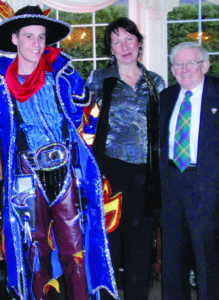
THE HUMOR
At the mass, the bishop can barely contain himself when the organ acts up and every beautifully sung hymn ends on a long mournful note because of trapped air in the pipes. Grinning, he thanks the choir “and the leprechaun in the organ.”
At the J.F.K. Award dinner, humor abounds as Mayor Mike Sullivan, who in an alternative universe would be a stand-up comedian, gives a good old-fashioned ribbing to honoree Joe Loughrey, a boyhood pal. Meanwhile, my sister Honora, my friend Irene, and I enjoy sitting around the dinner table with Kateri Walsh, who chairs the Ambassador Committee, her husband Dan, a former Marine, and sons Chris, Daniel, and Bennett.
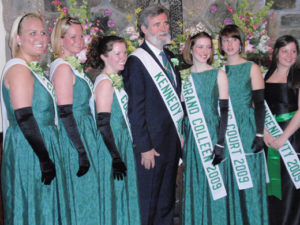
Chris regales us with stories of his trip to Ireland as Daniel tries to get a word in on the finer points of Irish culture, and Bennett, a lieutenant colonel, just back from his third tour in Iraq, tells us what the Shannon stop-off means to the American troops coming and going to Afghanistan and Iraq.
Kateri, honored with this year’s George E. O’Connell Award for her parade committee work, says she is “never happier” than when she has all her seven children together. They would all join her the following morning at the Mayor’s Breakfast and later on the parade route.
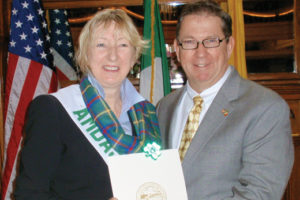
THE MAYOR & THE AWARD
The Mayor’s Breakfast, where I receive my Ambassador’s Award, is at the Yankee Peddler, which despite its name has a distinctly Southern feel. The main dining hall is a beautiful room with a magnificent chandelier from the old Metropolitan Hotel in New York City and a balcony where the Grand Colleen Ashley Tucker and her entourage hang out. The Mummers entertain, the Marine band plays, and Sgt. Dan Clark sings “It’s a Long Way to Tipperary,” just for me.
I was welcomed by David Pinsky who represents Tighe & Bond, sponsors of the Ambassador Award (James Tighe was an Irish immigrant to Holyoke who worked on the Hydroelectric dam which replaced the wooden structure in 1900. Tighe went on to become city engineer in 1911). I received several citations from city and state representatives and numerous gifts, and I am moved by the experience and at the same time worried about what I will say when my turn comes to speak.
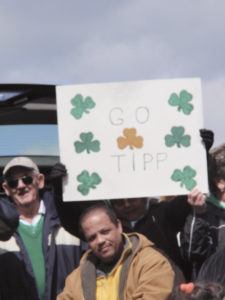
Luckily, Mayor Mike Sullivan does the introductions. A native son, who has been mayor for 10 years, Sullivan is passionate about Holyoke and prized for his sense of humor. He has everyone laughing so hard that I begin to relax. I realize, not for the first time, that in Holyoke, I am amongst my own. And so, I proudly accept the Ambassador’s Award on behalf of all the Irish immigrants who went before me.
The mayor has Kerry and Mayo roots: “My grandmother Bridget Kennedy was from Slea Head, and my grandfather Michael Sullivan was from Brandon Mountain. On my mother’s side, my grandmother Una Lavelle was from Belmullet, Co. Mayo, and my grandfather Nicholas O’Neill was from Cahirciven, Co. Kerry,” he writes in response to a follow-up e-mail I sent requesting more information on his family background. “As a second-generation Irishman, I loved sitting off to the side when I was young to hear stories of glory, tragedy, and opinion spun with thick brogues that were only translated through tumblers of Four Feathers or Seagram’s Seven.
“My Nana Sullivan was the only one I knew who was sweet and fierce with equal measure in all matters. She would approach the local butcher with praise, asking about his family, his wife, and his new car, and then when he would reveal the price of a hamburger she would use all that against him in an instant. ‘No wonder your flock are going to college and you are driving a new car – with the price of meat in this store it’s a wonder you don’t have a chauffeeeeeur,’ she would exclaim. It was a great lesson in politics. She also cared for me and my youngest sister while my mother was at work. I ended up having to go to speech class when I began elementary school because I would say ‘ba-a-ll’ and ‘ca-a-ll’ instead of ball and call, or ‘windell’ for window, or, as everyone in Holyoke still says, ‘pa-day-da’ for potato. The therapy broke my brogue.”
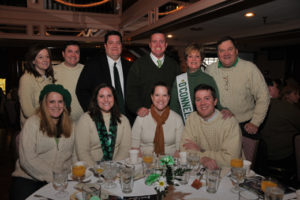
THE GIFTS
Holyokers really take the phrase “Irish hospitality” to new heights. Prized among the many gifts I received are a tartan scarf (Holyoke has its own tartan designed by Gerald Healy), a shillelagh, an Irish shawl from Cooper’s, and an autographed picture of Don Larsen’s perfect game.
I don’t know if Don Larsen, the Yankee pitcher who threw the no-hitter in the 1956 World Series between the New York Yankees and Brooklyn Dodgers, had any Irish roots, but his autographed photo, given to me by Dan Walsh, now has pride of place in my office. It is a reminder that sometimes miracles do happen, or maybe, in the case of those Irish immigrants to Holyoke, miracles didn’t so much happen as they were made. ♦
_______________
This article was originally published in the June / July 2009 issue of Irish America.
Editor’s Note: The 2023 Holyoke St. Patrick’s Day festivities kick off on Saturday, March 18th with the 46th St. Patrick’s Road Race at 12:00 pm and the JFK Award Reception at 6:00 pm. On Sunday morning at 7:30 am, the Ambassador’s Breakfast will take place at Wyckoff Country Club followed by the 70th Holyoke St. Patrick’s Day Parade at 12:00 pm on Northampton Street in Holyoke.
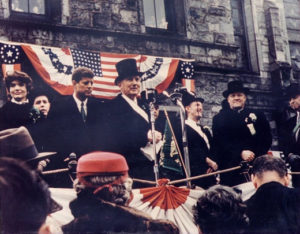
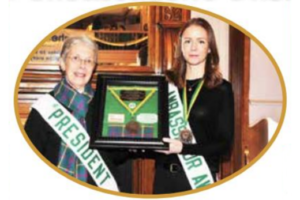
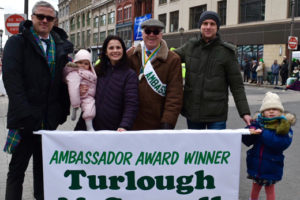
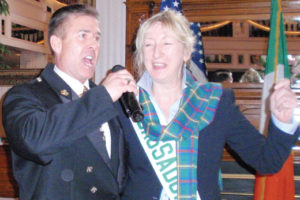

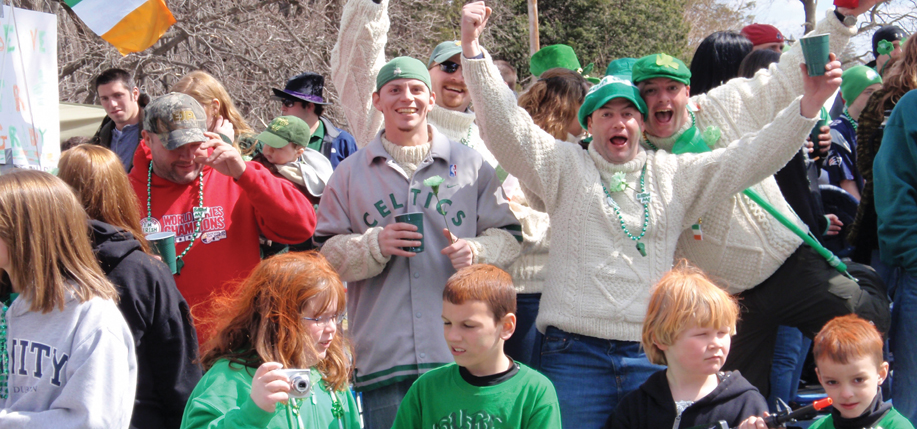
HI. I am interested in Una Lavele’s Familly.
As I am from Belmullet. And Lavelle is one of the most common on the Mullet Peninsula.
Regards
Phil Mc Intyre
Any connection to Canada? My family was also from Belmullet and was associated with a Sybil Lavelle in the Eastern Townships of Quebec.
Thank you for a wonderful lesson in history of how evolved the Irish were, better reading than a history book????????????????????????????????????
Great read just wondering is there any old Pictor maple street my great grandfather had a bar named O’Neill corner any help would be helpful